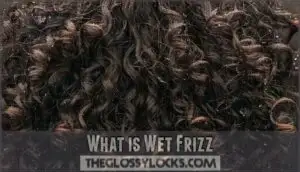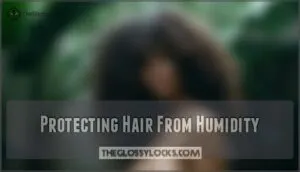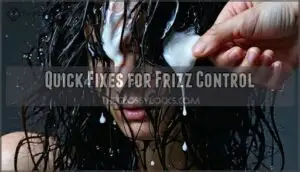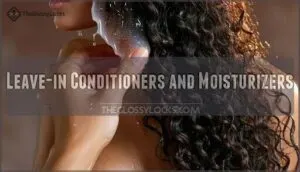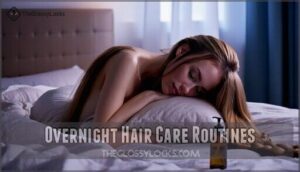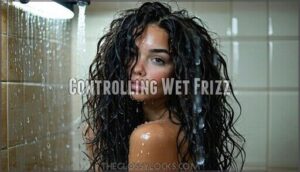This site is supported by our readers. We may earn a commission, at no cost to you, if you purchase through links.
 Wet frizz shows up when your hair looks unruly and frizzy while it’s still damp—a frustrating mix of too little moisture in some spots and too much in others.
Wet frizz shows up when your hair looks unruly and frizzy while it’s still damp—a frustrating mix of too little moisture in some spots and too much in others.
It’s often tied to high humidity, uneven hair porosity, or rough handling, like aggressive towel drying (your hair’s not a car, so skip the buffing!).
Curly hair is especially prone, thanks to its natural need for both moisture and protein balance.
Prevent it by being gentle: use a microfiber towel, hydrate with leave-in conditioner, and seal with lightweight oils.
Want consistently smooth, frizz-free hair? Small tweaks to your routine can work wonders.
Table Of Contents
- Key Takeaways
- What is Wet Frizz
- Preventing Wet Frizz
- Managing Wet Frizz
- Controlling Wet Frizz
- Frequently Asked Questions (FAQs)
- What does it mean if I have wet frizz?
- Does wet frizz need protein or moisture?
- How to make wet hair less frizzy?
- Does frizz mean lack of moisture?
- How does hair texture affect wet frizz severity?
- Can diet or nutrition impact wet frizz?
- Are there specific haircuts that help reduce wet frizz?
- Can hormonal changes affect the occurrence of wet frizz?
- How does water temperature impact wet frizz?
- Can hair type influence severity of wet frizz?
- Conclusion
Key Takeaways
- Handle your hair gently—use a microfiber towel, avoid rough drying, and detangle with a wide-tooth comb to minimize wet frizz.
- Keep your curls hydrated with lightweight leave-in conditioners and seal with oils to maintain moisture balance.
- Protect your hair from humidity by using anti-frizz serums, applying products evenly, and sleeping on silk pillowcases.
- Balance moisture and protein in your routine—too much of either leads to frizz, brittle strands, or limp hair.
What is Wet Frizz
Wet frizz happens when your hair looks frizzy, stringy, and unmanageable while it’s still damp, especially after washing.
It’s common in curly or wavy hair and occurs when moisture balance or hair care techniques are off.
Definition and Characteristics
Wet frizz happens when your hair’s natural curl pattern gets disrupted while damp, leaving strands stringy and undefined, instead of smooth and bouncy. It’s common in curly or wavy hair types, especially during post-wash stages.
Wet frizz leaves curls stringy and undefined after washing, disrupting their natural bounce and smooth, glossy texture.
- Develops when hair’s damp.
- Leaves hair unmanageable.
- Creates stringy textures, not defined curls.
- Commonly affects curly, coily textures.
- Results from disrupted curl patterns during styling, leading to hair that is not smooth.
Causes of Wet Frizz
Hair frizz starts when your strands miss out on balanced moisture or face hair porosity issues.
Balanced moisture is the key to defeating frizz—nurture your strands and unlock smooth, defined curls every time!
pH imbalance, product buildup, and mechanical damage—like rough towel-drying or over-brushing—don’t help either.
Environmental factors, such as humidity, swell cuticles, leaving frizzy hair unruly.
Low moisture keeps curls dry, while protein overload stiffens strands, fueling wet frizz struggles.
Addressing hair porosity can substantially improve frizz control.
Effects on Curly Hair
When wet frizz appears, it can wreak havoc on your curly hair. You’ll notice styling challenges, from disrupted curl definition to uncooperative hair strands.
It’s like your hairstyle has its own agenda! The effects often include:
- Tangled and sticky curls increasing breakage risks.
- Manageability issues during and after washing.
- Hair frizz overpowering hair definition.
- Tough evenings taming wild textures.
The combination of these issues can lead to significant styling problems, making it essential to address frizz to maintain healthy and beautiful hair.
Hair Porosity and Moisture
Hair porosity controls how your hair absorbs and retains moisture, playing a key role in managing wet frizz.
High porosity hair soaks up moisture quickly but loses it just as fast. Low porosity hair resists moisture, causing product buildup.
Find balance with hydration methods and protein-rich products to smooth the hair cuticle and avoid frizz. Understanding hair’s moisture retention is essential for proper hair care.
| Porosity Type | Absorption Rate | Retention Ability | Main Issue | Fix |
|---|---|---|---|---|
| High Porosity | Fast | Poor | Dry, frizzy hair | Moisture sealing products |
| Low Porosity | Slow | Moderate | Buildup | Clarifying and deep moisture |
| Medium Porosity | Balanced | Balanced | Minimal | Consistent, light hydration |
| High Porosity | Fast | Poor | Hair swelling | Protein and hydration mix |
| Low Porosity | Slow | Moderate | Dry appearance | Warm water penetration |
Inadequate Hair Care Techniques
Skipping proper care invites chaos for your curls. Rough towel-drying, improper detangling, and over-manipulation lead to a frizzy hair nightmare.
Add product buildup or infrequent washing, and wet frizz becomes inevitable.
Using silk pillowcases can minimize overnight friction.
Treat your strands kindly—swap rough towels for microfiber, gently detangle with a wide-tooth comb, and stick to a consistent hair care routine to keep hair frizz prevention on track.
Environmental Conditions and Humidity
Humidity’s impact can take frizzy hair to new levels of chaos.
Geographic location and seasonal changes play a big role, especially when dew points rise above 60°F.
You’ll notice:
- Hair swelling and losing definition
- Humidity frizz creating unmanageable textures
- Atmospheric moisture disrupting your style
- Pollution effects making wet frizz worse
Fighting frizz? Start by understanding your environment.
Lack of Moisture and Protein Balance
Too much moisture or protein throws your hair’s balance off, leading to wet frizz.
Over-moisturizing causes hygral fatigue—making strands weak and stringy. Protein overload leaves hair brittle and prone to breaking.
Focus on moisture retention and balancing both through product layering and gentle care.
Restore balance with masks and treatments specifically designed for moisture imbalance or protein balance. It really works with proper care.
Preventing Wet Frizz
You can prevent wet frizz by using gentle techniques that reduce friction and protect your hair’s natural structure.
Start with proper hydration, avoid rough towel drying, and apply lightweight products to lock in moisture and shield against humidity to prevent wet frizz by using gentle techniques.
Gentle Hair Care Techniques
Handling frizz starts with gentle care. Treat your hair like a delicate fabric. Harsh routines cause chaos in hair strands.
- Use a soft towel for blotting to avoid frizz.
- Comb with a wide-tooth tool to prevent tugging.
- Sleep on silk pillowcases for reduced friction.
- Apply products evenly to seal hydration.
- Choose low-heat diffusing for smooth hair drying.
To further reduce friction, consider using pure silk scrunchies for smooth hair drying.
Minimizing Friction and Breakage
Switching up your routine can save your hair from wet frizz and breakage.
Swap cotton pillowcases for silk to reduce friction, and try T-shirt drying instead of rough towels to protect hair cuticles.
Use gentle detangling brushes, starting at the ends to prevent tangling, and opt for protective hairstyles, combined with even product application, to keep strands smooth and stress-free.
Protecting Hair From Humidity
Protecting your hair from humidity is all about creating a solid frizz defense.
Use humidity barriers like anti-frizz serums or sprays to lock in hair moisture.
Product sealing with leave-ins and lightweight oils helps combat wet frizz during damp days.
Explore options for humidity control products to further enhance your hair’s protection.
For overnight protection, try a silk pillowcase or sleep bonnet.
Don’t let climate impact steal your hair’s glory!
Managing Wet Frizz
You can manage wet frizz by making simple changes to your hair care routine, like using a lightweight leave-in conditioner or a microfiber towel.
Paying attention to hydration and avoiding rough handling keeps your curls smooth and defined, even when damp, which helps to manage wet frizz.
Quick Fixes for Frizz Control
When wet frizz strikes, grab a microfiber towel for gentle drying—no friction, no chaos.
A quick spritz of leave-in conditioner or hair serum can tame strands in seconds.
For emergency defrizzing, try product layering with lightweight anti-frizz creme.
Humidity hacks, like spritzing a protective spray, work wonders.
Overnight solutions? Sleep on silk and wake up smooth!
Leave-in Conditioners and Moisturizers
Taming wet frizz starts with a good leave-in conditioner. It locks in hair moisture, boosting hydration while making styling easier.
Use one with nourishing ingredients like aloe or argan oil for scalp health and shiny curls. Application techniques matter—distribute evenly on damp hair.
Consider experimenting with DIY recipes or layering moisturizing products for extra hydration. Many find that the best leave-in conditioners contain natural oils.
- Use a lightweight leave-in for soft curls.
- Choose products with natural oils or humectants.
- Apply in sections for even distribution.
- Don’t forget to moisturize your ends—they’re usually the driest!
Lightweight Hair Creams and Oils
For tackling wet frizz, lightweight hair creams and oils are game-changers.
They smooth strands, combat product buildup, and improve scalp health.
Look for cream ingredients like keratin for hair smoothing and oils like jojoba for hydration.
Apply sparingly, focusing on damp hair.
Many people find success using these hair product options.
This method locks in moisture, boosts anti-frizz benefits, and keeps your curls defined and manageable.
Overnight Hair Care Routines
Why does your hair seem to party overnight without you?
With proper overnight hair care, you can wake up to smoother curls.
Use silk pillowcases or bonnets for hair protection, minimizing friction. For example, many people find silk provides hair benefits.
Try protective hairstyles like braids or buns to reduce tangles.
Hydration techniques, like pre-bed product application, help lock in moisture, preventing hair breakage. Sweet dreams, frizz-free mornings!
Controlling Wet Frizz
To control wet frizz, focus on maintaining moisture in your hair and handling it gently during your routine.
Avoid harsh chemicals, excessive heat, and friction, as these can disrupt your curl pattern and worsen frizz.
Hair Care Routine and Tips
Your hair care routine holds the secret to frizz prevention. Stick to these tips for consistent results:
- Focus on scalp health with gentle cleansing.
- Use effective product application by evenly distributing conditioners and stylers.
- Employ microfiber towels or air drying methods to minimize frizz.
- Protect strands overnight with bonnets or silk pillows.
- Maintain routine consistency for long-term benefits.
Consider using silk pillowcases to reduce friction and improve your overall hair care routine for a better hair experience.
Importance of Hydration and Moisture
Keeping your curls hydrated is your hair’s best defense against wet frizz.
Hydration benefits go beyond softness—they prevent dryness and promote moisture retention. Choose products with hydrating ingredients like aloe or glycerin. Regular deep conditioning maintains hair moisture balance, while lightweight oils seal in moisture.
Think of it as your hair’s ultimate drink of water—it won’t regret it!
| Cause | Effect | Solution |
|---|---|---|
| Lack of hydration | Increased frizz | Use deep conditioners |
| Low moisture retention | Dry, brittle hair | Apply moisture-sealing oils |
| Improper ingredients | Unbalanced texture | Choose hydrating products |
| Over-styling | Broken strands | Incorporate rest days |
| Climate challenges | Frizz in humidity | Use anti-humidity serums |
Avoiding Harsh Chemicals and Heat
Skip harsh chemicals and heat styling—they’re like kryptonite for your hair.
Opt for chemical-free alternatives like sulfate-free shampoos and natural ingredients for gentle processing.
Embrace heatless styling with protective styles like twists or braids.
These anti-frizz hair frizz solutions keep wet frizz at bay while saving your strands from damage, and your curls will thank you later with beautiful results.
Frequently Asked Questions (FAQs)
What does it mean if I have wet frizz?
It means your hair isn’t getting enough moisture or balance, causing strands to fray instead of clumping into curls.
Think of it as your hair’s SOS for hydration and a gentler care routine!
Does wet frizz need protein or moisture?
Your hair needs balance.
Too much protein makes it stiff; too much moisture leaves it limp.
Test products carefully. If it feels brittle, add moisture. If it’s stretchy or mushy, bring on the protein.
How to make wet hair less frizzy?
Imagine trying to towel-dry curls like rubbing a genie’s lamp—it doesn’t grant smooth hair.
Use a microfiber towel or T-shirt, apply leave-in conditioner, and gently rake for even product distribution to tame frizz.
Does frizz mean lack of moisture?
Frizz doesn’t always mean dry hair, but it often signals a moisture imbalance.
Your hair might lack hydration, have too much protein, or face damage.
Balancing moisture and gentle care can improve manageability.
How does hair texture affect wet frizz severity?
Your hair’s texture sets the stage—fine strands frizz faster, while coarse or thicker hair holds out longer.
Curly and wavy hair, with its natural bends, often battles frizz more fiercely when it’s wet.
Can diet or nutrition impact wet frizz?
Your diet plays a surprising role in hair health.
Essential nutrients like omega-3s, vitamins A and E, and zinc strengthen strands and improve moisture retention.
Neglecting nutrition? Your hair might misbehave, showing frizz as rebellion, which can be prevented by maintaining a balanced diet rich in essential nutrients.
Are there specific haircuts that help reduce wet frizz?
Taming unruly strands is like sculpting a masterpiece—choosing layered cuts or longer lengths helps distribute weight evenly, reducing chaos.
Avoid blunt ends; they can exaggerate frizz.
Face-framing layers or tapered ends offer sleek, manageable results.
Can hormonal changes affect the occurrence of wet frizz?
Yes, hormonal changes can impact your hair’s texture and moisture balance, making wet frizz more likely.
Shifts during pregnancy, menopause, or stress can disrupt your scalp’s oil production, leaving hair drier and prone to frizz.
How does water temperature impact wet frizz?
Ever wondered why hot showers can turn on you?
High water temperatures lift your hair’s cuticles, making strands more prone to frizz.
Stick to lukewarm water—it cleanses effectively without causing chaos.
Can hair type influence severity of wet frizz?
Your hair type absolutely influences wet frizz severity.
Curly and coily hair are more prone due to their natural structure, while porosity levels impact moisture absorption and retention, making some textures battle frizz more than others.
Conclusion
Did you know that about 65% of people deal with frizz-related issues, including wet frizz, due to humidity and improper care?
Thankfully, you can beat the frustration with simple tweaks like using microfiber towels, hydrating leave-in conditioners, and sealing lightweight oils.
Focus on balancing your hair’s moisture and protein levels while avoiding rough handling.
By embracing gentle practices and protective products, you’ll keep wet frizz at bay and enjoy smooth, manageable hair—rain or shine!
- https://www.ecoslay.com/blogs/blog/enoughs-enough-how-to-humidity-proof-your-curls-this-summer
- https://curluxscious.com/blogs/curly-blogs/wet-frizz?srsltid=AfmBOor6zAUzlAmrJ4OIe8ezLRV_PfG8mnrN3R90GaJHbmQBt70dc7Cw
- https://holisticenchilada.com/wet-frizz/
- https://controlledchaoshair.com/blogs/curly-hair-news/how-to-get-rid-of-wet-frizz
- https://bestlifenaturals.in/blogs/blog/what-is-wet-frizz-and-how-to-prevent-it?srsltid=AfmBOoo_RZcn2VEOeeoN8bUjgOxxCX_SWkzWxmeXB7V_-djWPIAqKvK9

